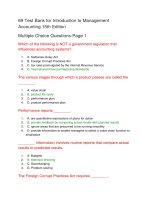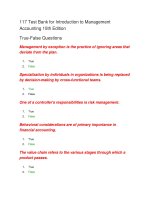group 3s assignment introduction to management samsung
Bạn đang xem bản rút gọn của tài liệu. Xem và tải ngay bản đầy đủ của tài liệu tại đây (741.39 KB, 13 trang )
<span class="text_page_counter">Trang 1</span><div class="page_container" data-page="1">
<b>FPT UNIVERSITY CAMPUS CAN THO</b>
</div><span class="text_page_counter">Trang 2</span><div class="page_container" data-page="2"><b>I. INTRODUCTION</b>
Samsung is one of the largest and most influential technology corporations in the world.Founded by businessman Lee Byung-Chul in 1938, with headquarters in Korea.Samsung Group operates in a wide range of sectors, with industries includingconstruction, consumer electronics, financial services, shipbuilding, medical services,and more. And the company's extensive product portfolio includes phones, watches,televisions and other consumer electronics. This report analyzes and evaluates topmanagement's management issues and challenges facing Samsung. In addition, it alsoincludes my team's recommendations for the company to solve those practical problems.
<b>Reasons for Choosing this Topic:</b>
The topic of analyzing management issues and challenges faced by Samsung was chosenfor several reasons. Firstly, Samsung is a globally recognized and influential companythat operates in diverse industries. By studying its management issues, we can gainvaluable insights into the complexities of managing a large and diversified organization,as well as understand the strategies and practices employed by industry leaders.Secondly, Samsung's market leadership in multiple sectors makes it an interesting subjectfor analysis. Exploring its management issues allows us to delve into various aspects ofmanagement, such as innovation, supply chain, and organizational structure. Byunderstanding how Samsung tackles these challenges, we can learn valuable lessonsapplicable to other companies facing similar issues.
<b>Importance of the Topic:</b>
The topic of analyzing management issues and challenges in Samsung holds significantimportance. Effective management is crucial for organizational success andcompetitiveness, and understanding the challenges faced by industry leaders like
</div><span class="text_page_counter">Trang 3</span><div class="page_container" data-page="3">Samsung provides valuable insights for improving management practices. By addressingthese challenges, Samsung can enhance its operational efficiency, innovation capabilities,and market position. Additionally, the topic contributes to the advancement ofmanagement theories and practices, providing valuable knowledge for professionals andresearchers in the field.
<b>Structure of the Report: I - Introduction </b>
<b>II - Methods and conceptual framework III – Analysis Results </b>
<b>IV – Conclusions & Recommendations </b>
II Method and Conceptual Framework for Analyzing Samsung:
Method: When analyzing Samsung, a combination of qualitative and quantitativeresearch methods can be employed. The qualitative approach involves gatheringinformation through interviews, case studies, and observations to gain a deeperunderstanding of Samsung's strategies, operations, and market positioning. This methodallows for capturing subjective insights and exploring the nuances of Samsung'sdecision-making processes.
On the other hand, the quantitative approach involves collecting and analyzing numericaldata related to Samsung's financial performance, market share, customer satisfaction, andother relevant metrics. This method provides a more objective and statistically supportedview of Samsung's performance in the market.
By utilizing a mix of qualitative and quantitative methods, a comprehensive analysis ofSamsung can be achieved, considering both the qualitative aspects of its operations andthe quantitative measures of its success.
Conceptual Framework: The conceptual framework used to analyze Samsung can drawupon various theories and models relevant to the field of business and technology. Somekey theoretical frameworks that can be applied include:
1. Porter's Five Forces: This framework helps in assessing Samsung's competitiveenvironment by analyzing the bargaining power of suppliers and buyers, the threat ofnew entrants, the threat of substitute products, and the intensity of competitive rivalry.2. SWOT Analysis: This framework enables an evaluation of Samsung's strengths,weaknesses, opportunities, and threats. It helps in identifying internal factors thatcontribute to Samsung's competitive advantage as well as external factors that may posechallenges or opportunities.
</div><span class="text_page_counter">Trang 4</span><div class="page_container" data-page="4">3. Innovation Theory: This framework focuses on Samsung's ability to innovate andadapt to changing market trends. It explores the company's research and developmentefforts, product differentiation strategies, and its ability to bring new and improvedproducts to the market.
By employing these theoretical frameworks, a comprehensive analysis of Samsung canbe conducted, considering its competitive landscape, internal strengths and weaknesses,market opportunities, technological advancements, and innovation capabilities.
<b>III. ANALYSIS RESULTS</b>
Analysis of Samsung's External Environment:
<b>PESTLE analysis of Samsung in Korea:</b>
Political factors:
Government Policies: The policies of the governments in the regions where Samsung conducts business may have a big impact on those operations. Samsung's business plans, for instance, may be impacted by factors such as tax laws, labor laws, environmental regulations, trade barriers and tariffs, and political stability. (Thestrategystory, 2023)International Relations: Samsung's business can be affected by diplomatic relationships between South Korea and other countries, as trade barriers or political tensions can impact the company's global operations.
Government Support: The Korean government has historically supported Samsung through various initiatives, including funding for research and development, infrastructure development, and incentives for attracting foreign investment.Economic factors:
Economic Conditions Worldwide: As a multinational firm, Samsung is impacted by the state of the world's economies. For instance, the spending power of consumers and the demand for Samsung's products might be impacted by economic booms or recessions in certain nations.
Exchange rates: Because Samsung operates internationally, changes in exchange rates may have an effect on the company's earnings. Samsung's products might cost more in
</div><span class="text_page_counter">Trang 5</span><div class="page_container" data-page="5">foreign markets if the South Korean won appreciates against other currencies, which might reduce sales. (Thestrategystory, 2023)
Sociocultural Factors:
Changes in lifestyle trends may have an effect on the market for Samsung's products. Forinstance, a greater focus on fitness and health may raise demand for wearable technology,such as Samsung's smartwatches, which have functions for tracking one's health.Demographics: The market for Samsung may be affected by demographic factors like population, age distribution, income levels, and educational attainment. For instance, younger demographics may be more likely to swiftly adopt new technology. (Thestrategystory, 2023)
Consumer Behavior: Socioeconomic factors, cultural preferences, and lifestyle trends in Korea influence consumer demand for Samsung's products. Understanding consumer behavior is crucial for Samsung to stay relevant in the market.
Technological Factors:
R&D capabilities: Samsung's R&D budget for 2022 is pegged at $19.4 billion. Samsung has a strong focus on research and development, allowing the company to introduce innovative products and stay competitive in the market. Technological advancement and protection of intellectual property rights are critical to Samsung's success.
Connectivity and IoT: The proliferation of internet connectivity and the Internet of Things (IoT) presents an opportunity for Samsung to expand its products, such as smart home appliances and wearables.
Legal factors:
Businesses in South Korea are governed by various laws that include Workplace Safety Act wherein the senior executives of the company can be held liable for work-related injuries and are liable for a fine and one-year imprisonment (Davies, 2021).
Intellectual Property Protection: Samsung operates in a highly competitive industry, and legal issues related to intellectual property rights and patents can impact its business operations and market position.
</div><span class="text_page_counter">Trang 6</span><div class="page_container" data-page="6">Consumer Protection Laws: These laws protect consumers from unfair business practices. Samsung must adhere to these laws in all areas, including advertising, product safety, and customer service.
Data Protection and Privacy Laws: With many of its devices storing or processing personal data, Samsung must comply with data protection and privacy laws, such as the General Data Protection Regulation (GDPR) in the European Union. (Thestrategystory, 2023)
Environment factors:
The electronics industry generates about 0.8 million tons of e-waste each year, and the Korean government has initiated various steps to control the pollution generated by the waste. This includes a GHG emission trading mechanism, whereby emission rights are allocated to companies with total annual emissions of not less than 125,000 tons of CO2. The electronics industry can greatly benefit from this plan including Samsung as it will legally help reduce emissions. (Kiara Miller, 2022)
Analysis of Samsung's Internal Environment:
<b>Porter's Five Forces:</b>
Threat of New Entrants:
Samsung operates in several industries, including consumer electronics, semiconductors, and mobile devices, which face moderate to high barriers to entry. These barriers include significant capital requirements, economies of scale, strong brand recognition, and extensive research and development capabilities. However, the threat of new entrants exists, especially in rapidly evolving technology sectors, where smaller companies or startups can introduce innovative products.( MBA Skool, 1022)
Bargaining Power of Suppliers:
Samsung's bargaining power of suppliers varies across its business units. For componentslike semiconductors, display panels, and memory chips, Samsung enjoys significant bargaining power due to its size and vertical integration, allowing it to source from its own supply chain. However, in other areas such as raw materials, software, and third-party components, suppliers may have more bargaining power, especially if they offer unique or critical inputs.
</div><span class="text_page_counter">Trang 7</span><div class="page_container" data-page="7">Bargaining Power of Buyers:
Samsung faces a relatively high bargaining power of buyers due to intense competition and a consumer-driven market. Buyers, including individual consumers, businesses, and retailers, have various options to choose from and can compare prices, features, and performance across different brands. This puts pressure on Samsung to continually innovate, offer competitive pricing, and provide excellent customer service to maintain customer loyalty. ( MBA Skool, 1022)
Threat of Substitutes:
The threat of substitutes is significant for Samsung, especially in the consumer electronics and mobile device sectors. Rapid technological advancements and product convergence have led to the emergence of alternative products that can perform similar functions. For example, smartphones face substitutes like tablets, wearable devices. Samsung needs to continually enhance its product offerings and differentiate itself to minimize the impact of substitutes.
Competitive Rivalry:
Samsung operates in highly competitive industries and faces intense rivalry from various global and local competitors. In consumer electronics, it competes with companies like Apple, LG, Sony, and Huawei, while in mobile devices, it faces competition from Apple's iPhone, Xiaomi, Huawei, and other smartphone manufacturers. Competitors often engage in price competition, product differentiation, marketing campaigns, and innovation, increasing the intensity of rivalry.
</div><span class="text_page_counter">Trang 8</span><div class="page_container" data-page="8">- established itself as a leading global brand known for innovation, quality.
- Samsung has a strong global presence
-<small> </small> Broad Product Portfolio.
- Dependence on Android- product recalls and legal disputes-<small> </small> Product Differentiation
<b>-<small> </small></b> 5G, artificial intelligence, Internetof Things (IoT), and augmented reality (AR)
-<small> </small> is a major player in the semiconductor industry, and the increasing demand for memory chips, processors
<b>-<small> </small></b> Intense Competition- Rapid Technological Changes- Legal and Regulatory Challenges
Based on the analysis of external and internal factors, Samsung can continue investing heavily in research and development to maintain a competitive edge and develop groundbreaking technologies across various product lines. Focus on areas such as AI, 5G,and Internet of Things (IoT) to drive innovation and stay ahead of competitors. Samsung could consider expanding into new markets or product categories to reduce dependency on specific segments and tap into new revenue streams. This could involve exploring opportunities in emerging markets, such as India and Southeast Asia, where there is a growing middle class and increasing demand for consumer electronics. Additionally, Samsung can explore adjacent markets like smart home devices, healthcare technologies,
</div><span class="text_page_counter">Trang 9</span><div class="page_container" data-page="9">or automotive electronics, leveraging its expertise and brand recognition. Samsung can explore strategic partnerships and collaborations with other companies, startups, or research institutions to leverage their expertise and accelerate innovation. Collaborations can help Samsung enter new markets, access complementary technologies, and foster a culture of collaboration and open innovation.
<b>Management issues:</b>
Supply Chain Management:
Samsung, as a global manufacturer, faces challenges in managing its complex and extensive supply chain. Analyzing this issue involves considering factors such as: Supplier Relationships: Samsung needs to maintain strong relationships with suppliers toensure timely and reliable delivery of components and raw materials. Building strategic partnerships with key suppliers can help secure the supply chain and mitigate risks.Quality Control: Samsung must implement rigorous quality control measures to ensure the reliability and performance of its products. This includes implementing strict quality assurance processes, conducting audits, and collaborating closely with suppliers to address any quality issues promptly.
Sustainability and Ethical Practices: Managing sustainability throughout the supply chainis essential for Samsung's reputation and meeting consumer expectations. The company needs to enforce ethical practices, promote environmentally responsible manufacturing, and ensure fair labor conditions throughout its supply chain.
Talent Acquisition and Retention:
Attracting and retaining top talent is crucial for Samsung's ongoing success. Key factors to consider include:
Employer Branding: Samsung must effectively communicate its employer value proposition and create an appealing work environment to attract top talent. This involves showcasing the company's culture, opportunities for career growth, and commitment to innovation.
</div><span class="text_page_counter">Trang 10</span><div class="page_container" data-page="10">Talent Development: Samsung needs to invest in training and development programs to enhance employees' skills and competencies. This includes offering learning
opportunities, career advancement paths, and mentorship programs.
Employee Engagement: Maintaining high levels of employee engagement is crucial for talent retention. Samsung should foster a positive work culture, promote work-life balance, recognize and reward employee contributions, and provide opportunities for meaningful involvement and empowerment.
User Experience: Samsung needs to focus on enhancing the overall user experience, including user interfaces, product design, and customer support. This involves studying user feedback, conducting usability tests, and implementing iterative improvements based on customer preferences.
Branding and Marketing: Samsung should invest in effective branding and marketing strategies to position itself as a premium and trusted brand. This includes targeted marketing campaigns, building emotional connections with consumers, and highlighting key differentiators in its product offerings.
Strategic Partnerships and Alliances:
Strategic partnerships and alliances can provide Samsung with competitive advantages and growth opportunities. Key considerations include:
</div>








